Hollywood Elsewhere will have a seat at L.A.’s Kodak Theatre (i.e., where the Oscars have happened for the last few years) this coming Thursday for the final Democratic Primary debate — Obama, Clinton, Edwards — prior to “tsunami Tuesday” on 2.5. The show will air from 5 pm to 7 pm Pacific.
Ugly strike scenario
Past Deadline‘s Ray Richmond has passed along an “undeniably pessimistic and hardcore but I believe at least semi-plausible theory” about what may soon be going on regarding WGA-AMPTP negotiations:
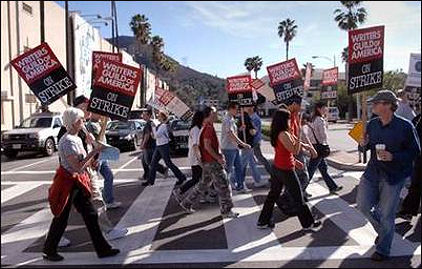
“The studios make a deal with the Directors Guild, whose residual guarantees don’t come close to matching what the WGA is seeking. A producer rep circulates around the idea that things are looking up and informal talks have commenced. There is a resumption of in-person bargaining, followed quickly by an abrupt break-off and the usual angry recriminations along the lines of ‘So it seems those arrogant bastard writers think they’re worth more than the directors!’ and “We held out an olive branch and they ripped it to shreds!”.
“The producers still have done nothing to move the talks forward — or in truth even start them — yet can seize the moral high ground. The WGA side will have been lured into a trap. The premise postulates that the studios have zero interest in ever coming to a reasoned agreement but are instead moving resolutely forward on a campaign of solidarity splintering and ultimate guild destruction.”
A “creative paycheck” gig for Del Toro?
Having delighted at the aesthetic development and career-growth arc of the great Guillermo del Toro over the last 15 years (i.e., from 1993’s Cronos to Hellboy 2), I’m a tiny bit sorry to read that he’s on the verge of taking a job to direct back-to-back installments of J.R.R. Tolkien‘s The Hobbit, according to the Hollywood Reporter‘s Borys Kit.
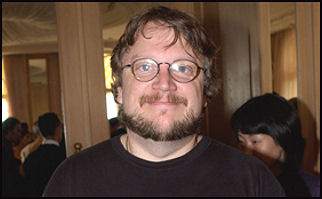
Guillermo will do an excellent job, I’m sure, for his employers — producer Peter Jackson and New Line and MGM — and the fans will be with him, but cranking out two more Tolkien movies after the Lord of the Rings trilogy…yeesh. Where is the genuine hunger to see these films made beyond the New Line stockholders who will profit from them? Del Toro is an old soul who’s capable of much, much more than taking what amounts to a “creative paycheck” job of this sort and playing the jolly maestro for a symphony that has already been written, played and, in a literary sense, digested. Where is the discovery or the challenge for Del Toro in doing this?
At best he’ll get the kind of thumbs-up critical responses that Alfonso Cuaron got from directing Harry Potter and the Prisoner of Azkaban, which is to say he’ll get points for not making a cookie-cutter Peter Jackson movie — for inserting his own sense of narrative precision and visual style. I don’t want to say that a job like this is “strictly about making money and treading water” because I’m not privvy to the creative particulars, but it sure feels like this from my corner. Maybe I’m wrong but I can tell you this — Del Toro’s business manager is a lot happier about this deal than I am.
The glow from that fire
“If you’re ready to stop settling for what the cynics tell you you must accept, and finally reach for what you know is possible, then we will win these primaries, we will win this election, we will change the course of history, and light a new torch for change in this country — and ‘the glow from that fire can truly light the world.'”
Quentin vs. faux paparazzi
“What’s going on here? What’s going on here? What’s going on here? What’s going on here? What’s going on here? Put that down…what’s going on here? What are you doing? What are you doing…..[are you going] to talk to me? You’re actually a paparazzi guy? Oh, ’cause you’re filming? If that was off I’d be whipping your ass up and down the street.”
“Falling Slowly”‘s Eligibility
One thing that the Academy of Motion Pictures Arts & Sciences has been really, really good at this year is disqualifying or dismissing Oscar-worthy contenders. They disqualified Jonny Greenwood‘s There Will be Blood score. The foreign committee scrubbed The Band’s Visit and 4 Months, 3 Weeks & 2 Days. And now, according to N.Y. Times Oscar blogger David Carr (a.k.a. “the Bagger”), there is talk that “Falling Slowly,” the beautiful love ballad from Once, may be ruled ineligible for a Best Song Oscar.
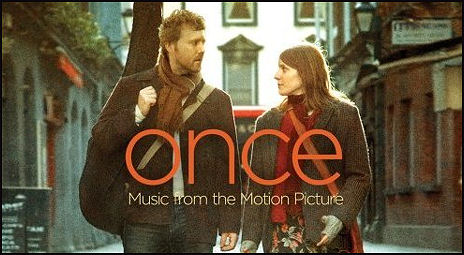
“An original song consists of words and music, both of which are original and written specifically for the film,” the Academy rules state. Carr says it is unclear how “Falling Slowly” may have run afoul of said rules, but the music branch of the Academy branch will be looking into the matter on Monday with a decision to follow soon after.
Carr advises readers to “wait until all the facts are in before commencing to freak out.” Okay, I’ll bide my tim. Bnd if the Academy rules against the eligibility of Glenn Hansard and Marketa Irglova‘s delicate, heart-lifting tune, it will really and truly be time to get out the torches and the pitchforks. I’ve used that metaphor before, but this is serious. These people seem to do nothing but say “no,” “no” and “not you either.”
A poster named “M” has written the following about this situation: “I believe, and correct me if I’m wrong, that Hansgard was so enamored with the song during the filming of the movie that he recorded it with his band for release, anticipating that Once would not get wide release and wanting to give the song as much exposure as possible. The song itself was specifically written for the film, but recorded a couple of times before the film released in the U.S.
“That said, if ‘Falling Slowly’ loses to some sugar candy crap from Enchanted, I’m giving up on the Oscars entirely.”
Followup: a story posted today by the Dublin-based RTE Entertainment states that “Falling Slowly” was written for the film and captured on tape in January 2006. It later appeared on ‘The Swell Season’, a 2006 album recorded by Hansard and Irglova that came out in April ’06. It was then re-recorded for The Frames last album ‘The Cost’, which was also released in ’06.”
Speaking to the Irish Independent, Once director John Carney said”we’re all discussing that [the eligibility of the song] at the moment to get clear, exactly, and figure this out.”
The RTE story states that Oscar officials “are likely to discount the fact that the song featured on two albums before it was released as part of Once, and are expected to focus on whether the song was specifically written for the film.”
Lane on “4,3,2”
4 Months, 3 Weeks & 2 Days “is not an issue movie,” writes New Yorker critic Anthony Lane in the current issue. “We are not being forced to vote, and the characters are defined less by any stated beliefs than by the moral texture of their actions.
“Look carefully at [the aobrtionist] Bebe as he unpacks his briefcase of crude tools: he is made faceless, filmed from chest to thigh, and that suits his status as a predatory machine. And, once he has departed, having exacted a terrible payment for his services, look at Otilia: She leaves Gabita to rest and goes, as promised, to her boyfriend√ɬ¢√¢‚Äö¬¨√¢‚Äû¬¢s parents√ɬ¢√¢‚Äö¬¨√¢‚Äû¬¢ house for a birthday dinner.
“There she sits at a table, surrounded by gleaming food and idle chatter, her thoughts miles away and fathoms deep. Again, hands reach in from the side, this time for pickles and wine, but the camera holds steady, minute upon minute, and we gaze at her, face to face. How can people feast when she has just come from the pits of degradation, and must shortly return to dispose of an unwanted fetus? Disposal, incidentally, is recommended via the garbage chute of a high-rise apartment building; try going from this film to Sweeney Todd, with its corpses dumped for comic effect, and see how long you last.
“All of which makes 4 Months, 3 Weeks and 2 Days sound more or less unwatchable. Mungiu√ɬ¢√¢‚Äö¬¨√¢‚Äû¬¢s pacing is so sure, however, in its switching from loose to taut, and the concentration of his leading lady so unwavering, that the movie, which won the Palme d√ɬ¢√¢‚Äö¬¨√¢‚Äû¬¢Or at last year√ɬ¢√¢‚Äö¬¨√¢‚Äû¬¢s Cannes Film Festival, feels more like a thriller than a moody wallow. When someone approaches Otilia from behind, on an ill-lit street, you brace yourself for the worst. But the film stops short of the worst, by an inch — or, rather, it becomes a concise survey of how to deal with the worst.
“Do you cave in helplessly, like Gabita? Do you sour into something nastier than the system that bred you, like Bebe? Or do you summon your depleted energy, like Otilia, and brave it out? If so, are we allowed to imagine her, two years later, crowding with tens of thousands of others in front of the Central Committee building and howling down a tyrant? You bet.”
Nolan on Ledger
“Heath was bursting with creativity. It was in his every gesture. He once told me that he liked to wait between jobs until he was creatively hungry. Until he needed it again. He brought that attitude to our set every day. There aren’t many actors who can make you feel ashamed of how often you complain about doing the best job in the world. Heath was one of them.” — from a 1.26 Newsweek tribute piece by Dark Knight director Chris Nolan.
“Rambo” Relish
I made good on my word this evening. I blew off a Santa Barbara Film Festival movie, walked down to the Fiesta Five and plunked down ten bucks to see Rambo. Maybe it was because I’ve been watching nothing but festival movies for the past week and a half, but it’s so relentlessly blunt, so absurdly violent in a ’70s exploitation vein, so visceral and depraved and elbow-deep in jungle blood & guts that I loved it.
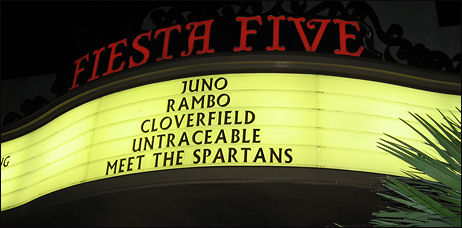
Every time a head got sliced or blown off, I laughed or let go with a big “yawww!” So did the mostly-male audience which applauded at the end. Everyone had a great time. I felt relaxed with these guys…bonded.
In other words, Rambo “works” in its own deranged way. It’s like an ultra-violent half-time show at the Super Bowl. It’s shit, of course, but it’s fast, fun and agreeably grotesque. Looking buff as hell and saying as little as possible, director-writer Sylvester Stallone keeps the action fast, tight and moist. It’s somehow exhilarating to watch scores of Burmese bad guys get their stomachs opened, bodies cut in half, windpipes ripped out, blown to smithereens (loved that thermonuclear claymore mine!)…and it just keeps getting better and better.
If you have any appreciation for coarse cheeseball action crap, you can’t help but be satisfied. Stallone deserves credit for taking things down to the brute-caveman level and unapologetically going to town.
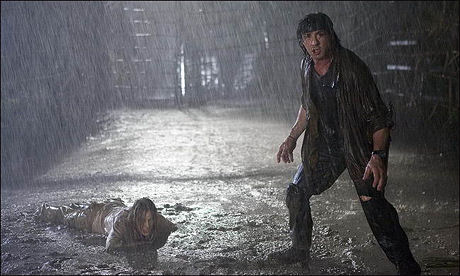
This is the second best Rambo film after First Blood, and although it’s obviously not meant to be “funny,” it is at times, wildly so. I laughed out loud on a good five or six occasions. Quentin Tarantino and Robert Rodriguez are going to love this thing. You could even make a case for Rambo being an instant porno-violent classic in the vein of Ron Ormond‘s The Monster and the Stripper, Alejandro Jodorowsky‘s Santa Sangre, Herschel Gordon Lewis‘s Blood Feast…that line of country.
Jamie Stuart’s take on Sundance ’08
Jamie Stuart‘s Sundance ’08 video short, just posted and costarring George A. Romero, Ellen Kuras, Stacy Peralta and “strange text messages.” Takes a while to load, run 8 minutes and 39 seconds.
SAG Awards
“The Coens are freaky little people, and they made a freaky little movie…whether you like the ending or not.” — the close of Josh Brolin‘s acceptance speech after the No Country for Old Men gang won the Best Cast award at the finale of tonight’s Screen Actors Guild Awards.

Other winners: Best Actor — Daniel Day-Lewis, There Will Be Blood (a reserved and eloquent acceptance speech that primarily paid tribute to Heath Ledger); Best Actress — Julie Christie, Away From Her; Best Supporting Actor — Javier Bardem, No Country for Old Men; Best Supporting Actress — Ruby Dee, American Gangster (hey…what happened to the Cate Blanchett vs. Amy Ryan contest?); Best Stunt Ensemble — The Bourne Ultimatum.

